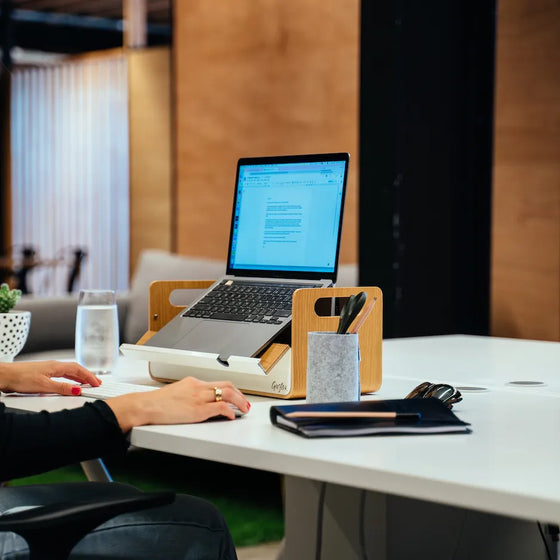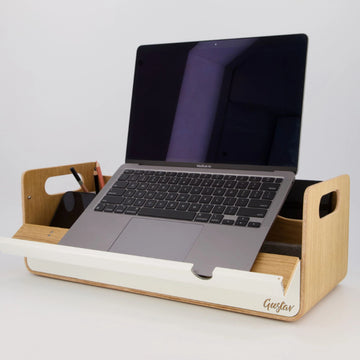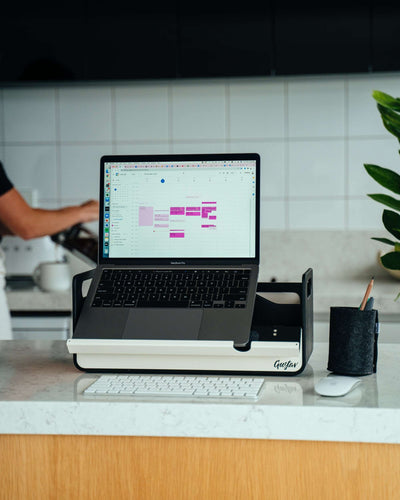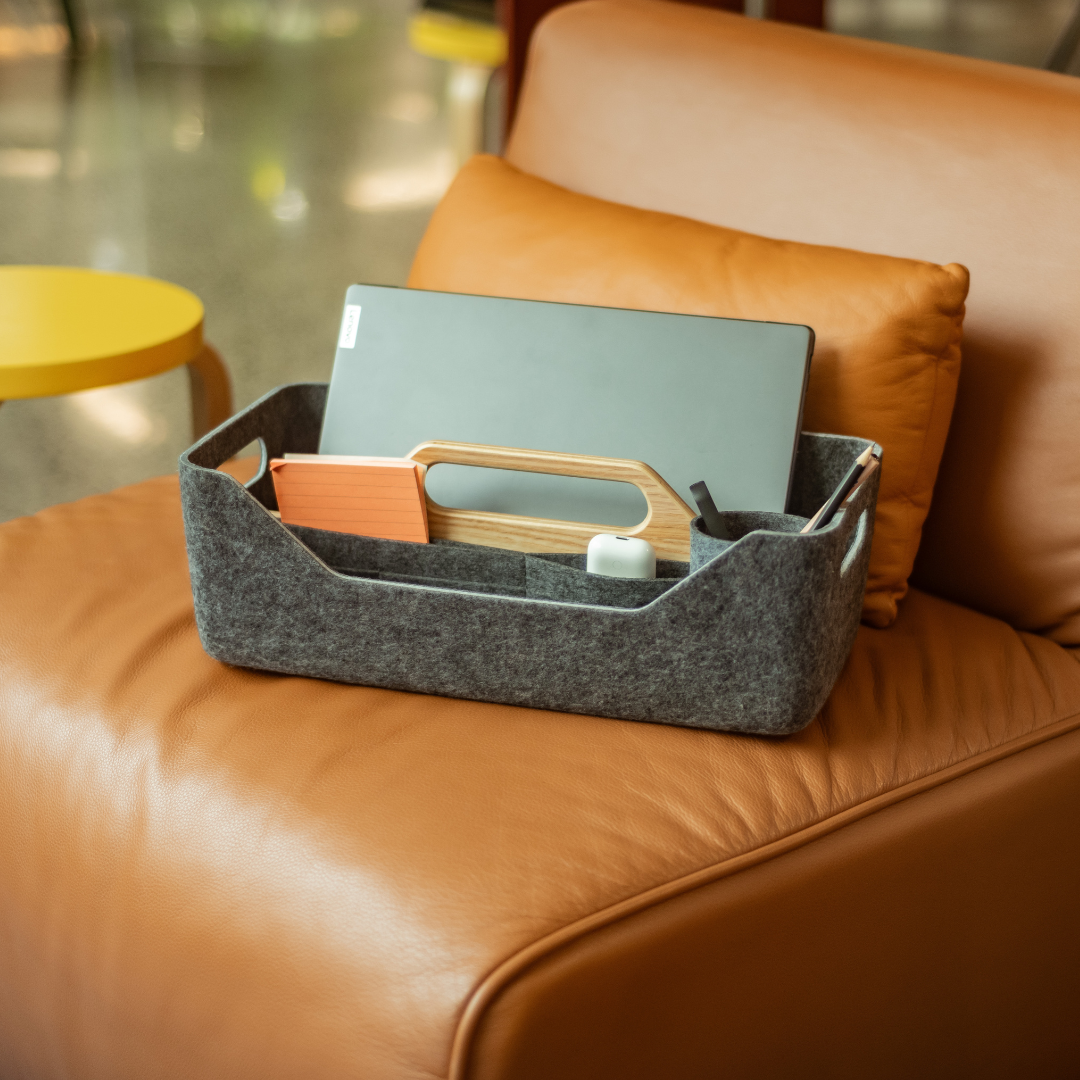How to create an ergonomic workplace

Tension, neck pain, headaches – if you spend many hours at your desk these will be familiar ailments. But does it have to be that way? Well, maybe not. If you learn to implement some ergonomic principles into your workplace, you can seriously reduce, or even eliminate, the pain you experience at your desk.
So What is Ergonomics?
The agreed definition of ergonomics is the mutual adaptation between people and their working conditions. This is key, as it tells us that it's not just the person who has to adapt, but also the circumstances in which they work. If you spend many hours at your desk, you should therefore not put up with back pain, but rather adapt your table, chair and everything else to your own personal needs.
Ergonomics in the workplace - the basics
You have probably heard some of these basic tips, such as sitting up straight and putting your feet on the floor before. But how exactly does this work? Two of the most important basic rules concerning ergonomic sitting are:
Desk height:
The desk should be height-adjustable. Ideally, the desk should have the ability to be converted into a standing desk, as working while standing not only helps provide fresh ideas, but also relieves the posture apparatus.
A sufficiently large table is also important. If you have piles of documents and books around you, you will quickly lose your overview - and who likes to work surrounded by files and to-do lists? A sufficiently large workplace ensures order and clarity and thus concentrated work.
The desk chair:
Most office chairs are height-adjustable nowadays. You should choose the chair height so that your feet are firmly on the floor and your legs are at an angle of more than 90°. If your chair has armrests, they should be adjusted so that the arm angle is 90-100°.
The optimum chair height does not always harmonise with the table. In such cases, you can help yourself with a cushion. A wedge cushion, for example, supports a straight posture and ensures that the pelvis tilts forward.
How to design your workplace ergonomically
If you want to set up your workplace ergonomically, you need to consider more than just the table and chair. It's also about sitting correctly, the light, the temperature and the right angle of the screen. All of this ultimately serves to make you feel comfortable at your workstation and increase your productivity
through efficient, distraction-free work. Sounds pretty good, huh? We will now explain step by step how to can set up your workplace in an ergonomically correct manner.

Fast and modern technology saves time
Are you surprised that technology also comes up when talking about ergonomic workplaces? Remember: ergonomics means mutual adaptation. Therefore fast, state-of-the-art technology is a must. With the right technology, you save a lot of time and increase your productivity.
Office climate - optimal air and temperature
Neither sweat nor cold hands are desirable in the office. The perfect temperature is around 20-22° C. You should also keep an eye on the humidity, especially in winter, when the radiators are running at full blast. If the air gets too dry, you can counteract this with a humidifier; between 40 and 60 % humidity is optimal.
Lighting - Light influences body rhythm
The saying that you should get up with the first rays of the sun and go to bed with the last rays is justified. After all, light influences our biorhythms - no wonder we have such a hard time getting out of bed in winter. If you have the feeling that you are constantly tired at your workplace, you should take a closer look at the lighting conditions there.
In the best case, your workplace should be flooded with natural daylight. This allows a good view of the screen. You should do without desk lamps; it is better if the light comes from the ceiling. This is because shadows on the keyboard have a distracting effect. Try different lighting options and find out in which lighting conditions you feel most comfortable.
The monitor - how to set it up correctly
The monitor should have a size of at least 24 inches. In order that you don't get a stiff neck, the upper edge of the screen should be at about eye level, with the monitor about arm’s length away.
The keyboard - avoid bending
Everyone knows about tennis elbow, but have you ever heard of mouse arm? Working with a keyboard and mouse for hours on end can lead to tendovaginitis and other repetitive strain injuries. Try to avoid bending your wrist as much as possible. This can easily be done by using specially designed foam pads that you can place in front of the keyboard and mouse.
There are also ergonomically shaped keyboards and computer mice available in specialist shops that allow a relaxed hand position. Don't worry, after a short period of time you will soon get used to these
specially curved keyboards and be able to work just as quickly as before, but in a much more relaxed way.
Special case: working with a notebook
All well and good, you may think, if you work with a notebook. But there are solutions for this too. Thanks to special notebook stands like Gustav, you can bring the monitor of your laptop to the right eye level. In addition, the device is protected from overheating. You can also connect an ergonomically correct keyboard to the notebook via Bluetooth or USB.
Another option is to use an external monitor. Connect the notebook to the monitor and a keyboard and you can easily set up your ergonomically correct workstation.

Taking a break - this is how to get a workout in the office
Even with the best ergonomic workstation, body and mind demand regular breaks. How about a short workout instead of a sweet chocolate bar? After all, a little exercise can replenish your energy and add a bit of interest to the office routine. What’s more, if you don't yet have an ergonomic workplace, there is a suitable exercise to help alleviate every ache and pain.
What helps against headaches?
Staring at the screen for a long time can cause headaches. Massage your temples to relax and relieve the pain. To avoid headaches, take regular breaks from your computer screen. Look out of the window or hold your index finger directly in front of your eye and then keep increasing the distance. This helps the eye to refocus and prevents fatigue.
What helps against a tense neck?
Circle your head slowly and carefully - sometimes to the left, sometimes to the right. Then hold your left temple with your right hand and gently pull your head to the right. At the same time, pull your left shoulder down. Repeat the process on the other side.
What helps against tense shoulders?
Circling your shoulders forwards and backwards brings relief. Also, be careful if you tend to pull your shoulders towards your ears - this is a classic example of tense ‘bad’ posture. So keep circling your shoulders back and pulling them down and relaxing. This will put you in an upright position, which will reduce pain.
What helps against back pain?
If your back hurts in the office, pull your arms and shoulders back and hold this position for 20 seconds. Relaxation is also good for you: just let your upper body fall forward with a heavy weight and give yourself a few seconds’ break.
Rotations also have a beneficial effect on the aching back: Simply place your left hand on your right shoulder and vice versa and turn your upper body as far as possible to the left and right and remain in this position for a few seconds.
What helps against aching and numb legs?
A little movement helps - and you don't even have to stand up to do it. Put your legs upright on the floor and lift your left and right heel alternately.
If you are at the photocopier anyway, then stand on your toes for a few seconds while waiting, then switch to your heels for a few seconds, and repeat.
The best tools for ergonomic work
Now you know how to set up an ergonomic workstation. With the right tools, it really doesn’t take too long, and the benefits are many. We’ve designed Gustav with all these principles in mind, so you can retain an ergonomic workspace, wherever you are. As a laptop stand, it ensures that the monitor is at the right height and that you can type in a relaxed manner. Thanks to the pen holder and compartments for mouse and mobile phone, you are perfectly equipped at all times and can comfortably take your ergonomically correct workstation with you wherever you go.









